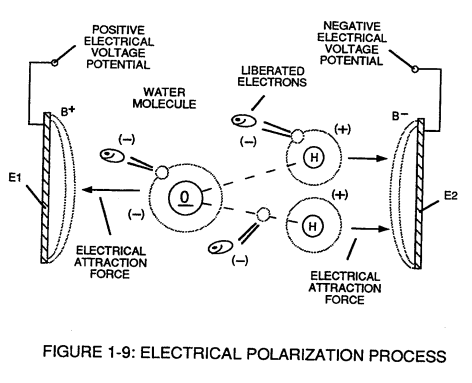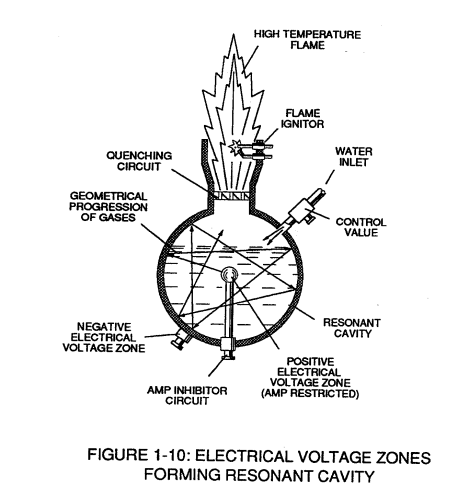Voltage Dissociation of The Water Molecule
Placement of a pulse-voltage potential across the Excitor-Array (ER) while inhibiting or preventing electron flow from within the Voltage Intensifier Circuit (AA) causes the water molecule to separate into its component parts by, momentarily, pulling away orbital electrons from the water molecule, as illustrated in Figure (1-9).
 The stationary "positive" electrical voltage-field (E1) not only attracts the negative charged oxygen atom but also pulls away negative charged electrons from the water molecule.
The stationary "positive" electrical voltage-field (E1) not only attracts the negative charged oxygen atom but also pulls away negative charged electrons from the water molecule.
At the same time, the stationary "negative" electrical voltage field (E2) attracts the positive charged hydrogen atoms.
Once the negative electrically charged electrons are dislodged from the water molecule, covalent bonding (sharing electrons) ceases to exist, switching-off or disrupting the electrical attraction force (qq') between the water molecule atoms.
The liberated and moving atoms (having missing electrons) regain or capture the free floating electrons once applied voltage is switched-off during pulsing operations.
The liberated and electrically stabilized atoms having a net electrical charge of "zero" exit the water bath for hydrogen gas utilization.
Dissociation of the water molecule by way of voltage stimulation is herein called 'The Electrical Polarization Process".
Subjecting or exposing the water molecule to even higher voltage levels causes the liberated atoms to go into a "state" of gas ionization.
Each liberated atom taking-on its own "net" electrical charge.
The ionized atoms along with free floating negative charged electrons are, now, deflected (pulsing electrical voltage fields of opposite polarity) through the Electrical Polarization Process
… imparting or superimposing a second physical-force (particle-impact) unto the electrically charged water bath.
 Oscillation (back and forth movement) of electrically charged particles by way of voltage deflection is hereinafter called "Resonant Action", as illustrated in Figure (1-10).
Oscillation (back and forth movement) of electrically charged particles by way of voltage deflection is hereinafter called "Resonant Action", as illustrated in Figure (1-10).
Attenuating and adjusting the "pulse-voltage-amplitude" with respect to the "pulse voltage frequency", now, produces hydrogen gas on demand while restricting amp flow.
